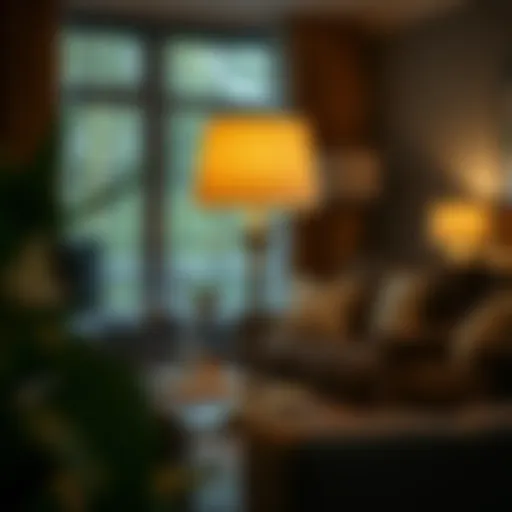Transform Your Space: The Impact of Wall Panels


Intro
As the world of interior design continually evolves, some concepts come and go, while others remain timeless. One such enduring element is the wall panel effect. This technique isn’t just about slapping up some boards on a wall; it’s a sophisticated method that can transform the very essence of a room. Wall panels can offer benefits that range from aesthetic satisfaction to practical applications, such as improving acoustics and enhancing thermal performance.
In this article, we’ll dig deep into the intricacies of the wall panel effect. Homeowners, interior designers, and decorators alike can glean insights on how to effectively integrate this design technique into various spaces. From understanding the various materials available to exploring design trends and styles, we aim to provide a comprehensive understanding of how wall panels can elevate an interior.
Wall panels have the power to reimagine spaces, making them feel cozier, larger, or even more formal depending on the design choices made. As we venture through the various aspects of this topic, take note of how you can apply these insights to craft interiors that are not only functional but also gracefully stylish.
Furniture Styles and Trends
Understanding the interplay between wall panels and furniture styles is crucial in creating a cohesive environment. Wall panels can complement or contrast various furniture styles, setting the tone for each room.
Exploring Popular Furniture Styles
Let’s look at a few furniture trends that go wonderfully with wall paneling:
- Mid-Century Modern: With its clean lines and natural wood materials, this style can beautifully harmonize with wooden paneling, enhancing warmth and character.
- Industrial Design: Metal and reclaimed wood furniture can strike an edgy contrast against smooth or textured wall panels.
- Minimalist Approach: Simple, functional pieces keep the focus on the wall panels, letting their beauty take center stage.
Understanding these styles aids in creating balanced interiors where wall panels and furniture work hand in hand.
Understanding Current Design Trends
The current design landscape is witnessing a resurgence of wall treatments in innovative forms. Popular trends include:
- Textured Panels: From 3D wall panels to intricate moldings, texture adds depth and interest to otherwise blank walls.
- Bold Colors: No longer just relegated to neutral tones, bold colored panels can become stunning focal points within a room.
- Eco-Friendly Materials: More homeowners prefer sustainable options like bamboo or reclaimed wood for finishes that appeal to eco-conscious sensibilities.
These trends ensure that wall panels are not just functional; they also make a statement.
Practical Tips for Furniture Selection
When choosing furniture to complement wall panels, several key considerations can help make the right decisions.
Factors to Consider When Choosing Furniture
When opting for furniture styles that will coexist with wall panels, consider the following:
- Proportion: Ensure that the size of the furniture works well with the wall paneling; oversized pieces may overpower delicate panel work.
- Material Harmony: Align materials—think of a wood panel paired with wooden furniture for seamless integration.
- Color Matching: Look to color schemes that either match or contrast effectively without clashing.
How to Measure and Optimize Space
To maximize your interior’s potential, taking precise measurements and planning the flow of space is essential:
- Start with a Floor Plan: Create a visual layout that helps you visualize where everything fits.
- Consider Movement: Ensure there’s enough space for easy navigation, especially when dealing with intricately paneled walls.
Through careful planning and thoughtful selection, homeowners can achieve a stylish and functional space that reflects their personality, while also leveraging the wall panel's transformative abilities.
"Wall panels can create not just boundaries between spaces; they can enhance the very character and experience of a room."
As the layers unfold, let’s continue exploring the myriad ways to make the wall panel effect a significant aspect of interior design.
Prelude to the Wall Panel Effect
When it comes to creating appealing and functional interiors, the wall panel effect stands out as a versatile tool for both homeowners and design professionals. This technique uses panels to change the look and feel of a space, integrating aesthetics with utility. Wall panels have gained traction over the years, and for good reason. They can enhance the overall atmosphere of a room, serve practical needs, and even affect how sound and temperature are perceived within a space.
Definition of Wall Panels
Wall panels refer to decorative and functional elements mounted on interior walls. They come in various materials, sizes, and styles, ranging from wood and metal to fabric options. These panels serve not just to beautify surfaces, but they also can provide additional insulation and soundproofing. By leveraging wall panels, designers can alter a room’s character, create focal points, or make a space feel larger or more intimate, depending on the chosen design.
Historical Context and Evolution
The use of wall panels isn't a modern gimmick; it has deep roots in the history of architecture and design. Historically, panels were often found in grand homes, where carved wood or richly painted surfaces adorned the walls, giving an air of opulence. Today, these elements have evolved significantly. For instance, fabric panels, once limited to use in curtains or upholstery, now grace walls, helping to soften sounds and add warmth to rooms.
In recent years, designers have expanded the palette of materials used for wall panels, incorporating recycled goods and eco-friendly options to address sustainability concerns. As society increasingly values social responsibility, the trend has given rise to a demand for panels made from reclaimed wood or bamboo, showcasing both ingenuity and a commitment to preserving our planet.
"Wall panels are not merely decorative. They are a means of transforming space, lending both style and function to every room."
Lastly, the digital age has made it easier for homeowners to visualize and implement wall panel effects in their spaces. Online tutorials, Pinterest boards, and virtual design software offer a plethora of ideas and techniques to explore before committing to a design choice. This accessibility opens the door for more people to experiment with styles that resonate personally, ensuring that their interiors reflect their unique tastes and preferences.
Aesthetic Implications
The aesthetic implications of wall panels are crucial in shaping the overall atmosphere and feel of a space. Choosing the right panel can breathe life into a room, enhancing not only its beauty but also how it reflects personality and mood. They work like a frame, setting the stage for what’s within the walls. Let's delve deeper into the various aspects of aesthetic appeal that wall panels contribute to interior design.
Enhancing Visual Appeal
Color and Texture Variations
The color and texture variations available in wall panels are nothing short of remarkable. These elements play a significant role in creating visual interest and can drastically alter the perception of a room. A bold hue, for instance, can act as a statement piece, while subdued tones can create a serene backdrop.
One key characteristic of color and texture is their capability to manipulate spatial perception. A textured panel might bring warmth and intrigue, while a smooth finish can lend a modern and clean look. This versatility makes it a popular choice in diverse interior settings, from minimalist apartments to cozy family homes.
Moreover, the unique feature of color and texture variations lies in their adaptive nature – they can be tailored to fit any design style. Yet, with options aplenty, it's essential to consider potential downsides. Some textures may require more upkeep than their flat counterparts, and dark colors can make a space feel smaller. Thus, selecting the right combination is paramount to achieving intended aesthetics without sacrificing functionality.
Patterns and Designs
The patterns and designs found in wall panels further elevate their aesthetic contribution. Whether opting for geometric lines or organic shapes, these elements offer a creative opportunity for expressiveness in design. Patterns can evoke emotions—elegant florals may impart charm, while bold stripes can energize a room.
A standout characteristic of patterns and designs is their capacity to guide the eye. A well-placed panel featuring a striking design can become a focal point, effortlessly drawing attention and anchoring the room. This attribute underscores why patterned panels are a popular choice among designers seeking to imbue spaces with character.
The unique feature of using patterns is that they can also create dynamic layers of complexity within a simple space. However, they require thoughtful consideration to avoid overwhelming a room, especially smaller areas where busy patterns might make the space feel cluttered or chaotic.
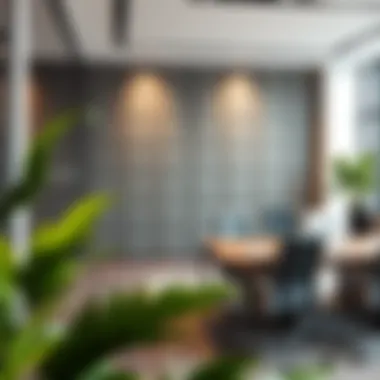
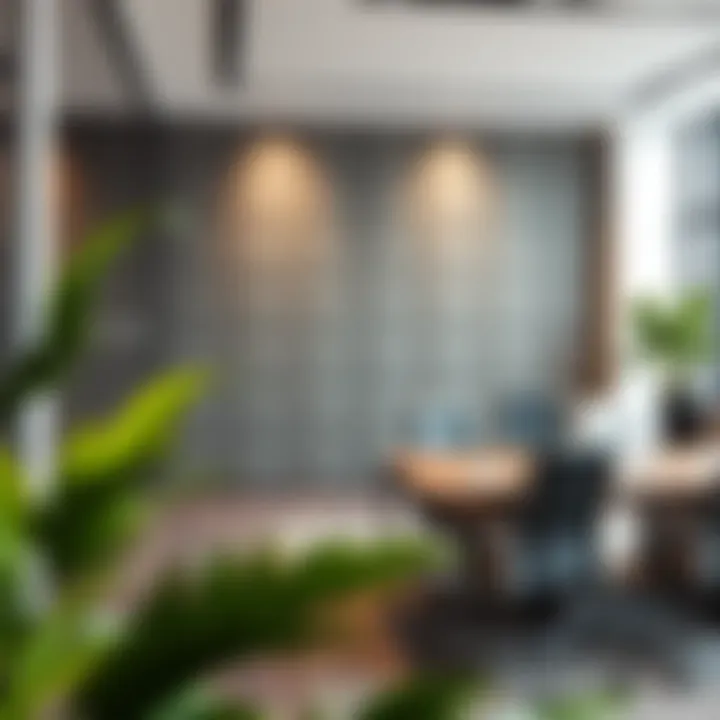
Creating Depth and Dimension
Visual Height
Achieving visual height is another pivotal aspect when discussing wall panels. Tall wall panels can elongate the room vertically, creating a sensation of spaces that soar. This optical illusion is particularly beneficial in rooms with lower ceilings, where typical dimensions may feel constricted.
The defining trait of visual height is its ability to structure the viewer's experience of a space, giving an impression of luxury and openness. It is especially advantageous in areas like dining rooms and living spaces, where a grand feeling might be desirable.
However, one must be cautious when opting for extreme heights. Extremely tall panels may require more materials and labor, increasing overall costs and complexity during installation. Therefore, it's a balance between maximizing aesthetics and managing practicalities in design.
Focal Points
Creating focal points through wall panels introduces an intentional element to interior design. Panels can effortlessly delineate certain areas, guiding attention to art pieces or architectural features. This strategy can enrich a design narrative, giving the eye something to linger upon amidst the varying elements in a room.
A major characteristic of effective focal points is their ability to enhance what’s truly important in a space. A well-placed panel can highlight a specific aspect—perhaps an elegant fireplace or a cherished painting—making them feel even more significant.
Yet, while beneficial, designing with focal points in mind can come with challenges. It requires a thorough understanding of the overall design to ensure that these focal areas don’t clash but instead harmonize. It’s essential to tailor them to the surrounding elements, maintaining a balance that promotes a thoughtful, cohesive design.
"In the end, aesthetic choices in wall panels drastically shape our experience of a space, turning a basic room into a special environment."
Functional Benefits of Wall Panels
Wall panels aren't just a pretty face in interior design; they pack a bang for your buck when it comes to functionality. Homeowners and designers alike are increasingly recognizing the dual role these panels play in creating stylish spaces while boosting practical benefits. This section dives into the two primary functional benefits: acoustic properties and thermal insulation. Each aspect brings a unique angle to the table, enhancing not only comfort but also the overall experience of a built-environment.
Acoustic Properties
Sound Absorption
One characteristic that puts wall panels in the spotlight is their sound absorption capability. This property is crucial for achieving a peaceful atmosphere, especially in residential areas or bustling commercial spaces. If you think about various settings—be it a home theater or an open-concept office—unwanted noise can easily disrupt the ambiance.
The way sound absorption works is through soft materials that trap sound waves. For example, panels made with fiberglass or specialized foam effectively prevent sound from bouncing around, creating a sound-friendly environment. This feature is especially popular among homeowners seeking to reduce distractions in busy households.
Moreover, this technique can significantly improve audio experiences in spaces dedicated to music or presentations. However, one must consider that while sound absorption works wonders for reverberation, it won’t eliminate all noises. It’s more about managing sound than completely blocking it, thus playing a critical role in enhancing calm and focus within the space.
"The strategic use of wall panels can transform an echoey space into a sanctuary of serenity."
Noise Reduction Techniques
When talking about noise reduction techniques, there’s a distinction to be made. This approach goes further than just sound absorption; it's about actively minimizing exterior noise intrusion. Think of it like fortifying your home against unwanted disturbances. This is particularly essential in urban settings where outside commotion is often unavoidable.
There are various ways to achieve effective noise reduction. Installing thicker panels or those with soundproofing layers can drastically decrease the decibel levels entering your space. Another effective method is ensuring that there is proper sealing around the edges of the panels, which prevents gaps where sound could seep through.
What's unique about noise reduction techniques is that they blend both aesthetic and practical elements. Homeowners can enjoy stylish wall panels that don’t just look good but also serve as a buffer against external chaos. However, it’s good to note that complete soundproofing is rarely achievable, but significant improvements can indeed be made.
Thermal Insulation
Moving beyond sound, thermal insulation is another significant advantage of wall panels. This factor often gets overlooked but can have a huge effect on the comfort level of a space. Wall panels can effectively trap heat during cold months and keep interiors cool in the sweltering summer.
Panels made from materials such as wood or insulated composites can significantly improve energy efficiency in a home. By retaining desired temperatures, they ultimately lower heating and cooling costs, making them an appealing investment for homeowners concerned about bills.
Furthermore, the insulating properties contribute to the home’s overall environmental performance. In a world increasingly focused on sustainability, panels that offer thermal regulation are becoming more sought-after. It’s not just about comfort—it’s about making responsible choices, too.
In summary, the functional benefits of wall panels can hardly be debated. From managing sound dynamics to improving energy efficiency, these attributes create spaces that are not just visually appealing but also inherently comfortable and efficient.
Types of Wall Panels
Understanding the various types of wall panels is crucial for anyone interested in interior design, whether you're a homeowner looking to spruce up your space or a professional designer crafting a sophisticated atmosphere. Wall panels come in different materials and styles, each offering unique properties that can enhance both aesthetics and functionality. In this section, we will delve into three primary types of wall panels: wood, metal, and fabric. Each has its own distinct character and practical considerations that can dictate their use in various settings.
Wood Panels
Wood panels bring a touch of warmth and elegance to any space. They can create a rustic vibe or a sleek, modern feel depending on the finish and design.
Natural Finishes
Natural finishes on wood panels highlight the grain and organic look of the material, creating a visual and tactile connection to nature. One important characteristic of natural finishes is that they can showcase the unique patterns found in wood, making each piece one-of-a-kind. This uniqueness is often seen as a beneficial choice for residential spaces, where owners desire to add character and warmth.
However, natural finishes also have certain maintenance requirements, as they may need periodic oiling or sealing to maintain their aesthetic over time. If neglected, they can fade or wear unevenly, but when cared for properly, they can last a lifetime, contributing to the overall charm of a room.
Composite Options
Composite wood panels are designed for those seeking a sustainable solution without sacrificing the look of natural wood. These panels often combine recycled wood fibers with resins, resulting in a durable material that's less prone to warping and cracking. The key appeal of composite options lies in their uniformity and ease of installation. As a popular choice, they can save time and effort while delivering a seamless and polished look.
That said, their synthetic nature sometimes lacks the warmth that natural wood offers. Additionally, while they may offer good resistance to moisture, the chemical components can raise concerns for eco-conscious consumers.
Metal Panels
Metal panels are another exciting option, often utilized for their industrial aesthetic and durability. They can make a strong visual statement in both residential and commercial settings, reflecting modern design trends.
Styles of Metallized Surfaces
There’s a range of styles for metal panels, including brushed, polished, and powder-coated finishes. Each style brings forth its own distinguishing features. For instance, brushed finishes tend to hide scratches effectively, making them a favorable choice for high-traffic areas. On the contrary, polished surfaces create a visually striking effect, ideal for modern interiors.
Choosing a metallized surface enhances the project's overall look while ensuring durability. However, care must be taken, as polished surfaces may show fingerprints more readily, requiring regular cleaning to maintain their appeal.
Durability and Care
When it comes to durability, metal panels have a significant edge over other materials. They resist fading, moisture, and pests, making them an exceptional choice for environments prone to wear and tear. The care for these panels is straightforward: simply wiping them down with a damp cloth will do the trick. This ease of maintenance makes them particularly beneficial in commercial settings, where upkeep budgets can be tight.
However, any dents or significant damage to metal panels can detract from the overall aesthetic. Repairing or replacing a panel can also be more complex than with wood or fabric options.


Fabric Panels
Fabric panels have carved out a niche in the interior design world, providing texture and sound absorption that wood and metal cannot match.
Textile Choices
The range of textile choices for fabric panels is vast, from luxurious velvet to practical polyester. Textiles can bring warmth and comfort to spaces that otherwise feel cold or sterile. The versatility of fabric panels allows designers to tailor them according to the specific atmosphere they want to create. For example, a rich, dark velvet can lend an air of sophistication to a lounge, whereas lighter linens may make a space feel airy and casual.
Nevertheless, fabric panels do require more maintenance. They can attract dust and stains, which necessitates regular cleaning to keep them looking fresh. This can be a downside for some, particularly in homes with kids or pets.
Applications in Design
Fabric panels are often used in applications where acoustics are vital. For instance, in recording studios or conference rooms, these panels can mitigate unwanted noise and contribute to a more pleasant environment. They are also utilized in residential spaces for softening the impact of hard surfaces, providing a cozy feel.
While they are not as rugged as wood or metal panels, their aesthetic and functional benefits can far outweigh their downsides, especially in specific contexts where sound insulation is a priority.
Installation Techniques
The choice of installation techniques plays a vital role in how wall panels function within a space. Proper installation ensures not only the aesthetic appeal of the wall panels but also their durability and functionality. Homeowners and designers alike must consider the unique requirements of the materials being used, as well as the specific environmental factors at play in the intended setting. By understanding both preparation and securing methods, individuals can achieve an impactful wall panel effect that resonates with their design vision.
Preparation of Wall Surface
Before laying down any wall panels, preparing the wall surface is essential. This step includes cleaning, smoothing, and ensuring that the wall is structurally sound. Any lingering dust, debris, or inconsistencies can lead to problems down the line. It is akin to laying a solid foundation before erecting a sturdy building.
- Cleaning: Removing any dirt, grease, or old paint can significantly enhance the adhesive properties of the mounting solution and contributes to a seamless finish.
- Smoothing: Uneven surfaces can lead to visible imperfections once the panels are installed. A level wall allows for a more polished appearance, ensuring that each panel aligns neatly with the next.
- Checking for Moisture: Some materials are sensitive to humidity. It is wise to check for any dampness which could warp or damage the panels later.
Securing Methods
Securing wall panels can be done through various methods; mainly, these can be broken down into adhesive techniques and mechanical fastening. Each approach has its own merits and downsides that can impact the overall outcome of your project.
Adhesive Techniques
Adhesive techniques refer to the process of using glue or other substances to attach wall panels directly to the surface. This method is a popular choice among DIY enthusiasts and professional designers for several reasons. One of the key characteristics of adhesive techniques is their simplicity. They often do not require specialized tools or equipment, making them accessible to a broader audience.
"With the right adhesive, even a rookie can make walls look like a pro's job."
A standout feature of adhesive techniques is the clean installation. There are no visible screws or nails to interfere with the aesthetics of the panel design, leading to a more streamlined look. On the downside, adhesives can sometimes have limitations based on the material compatibility and may require curing time before the panels are subjected to stress or weight. They are also less forgiving when adjusting positions post-application, meaning once it's set, it's usually best to leave it be.
Mechanical Fastening
Mechanical fastening involves using screws, nails, or brackets to secure wall panels in place. This method is often seen as a robust choice, especially for heavier materials or in high-traffic areas. A noteworthy aspect is the strength it provides, ensuring the panels resist wear over time while also being more adaptable to future changes in design or layout.
The unique feature of mechanical fastening is the ease of removal and replacement. If a panel gets damaged or if a homeowner desires a change, it can be taken down without leaving adhesive residue behind. However, a downside is that visible fasteners can detract from the overall finish unless carefully planned in alignment with design elements.
In summary, the selection of securing methods reflects the design intent as much as the practicality of the material choice. Both adhesive techniques and mechanical fastening present valid routes to creating effective wall panel installations, each catering to different styles and user requirements.
Case Studies
Case studies are essential when diving into the wall panel effect. They showcase how different designs can be shaped through practical applications of wall panels in various living and commercial spaces. By examining real-world examples, both homeowners and design professionals gain insights into effective strategies, materials, and aesthetics that elevate interior environments.
This section will not only highlight the successes but also address the challenges encountered. Understanding these experiences can inform choices and lead to better outcomes in design projects. Whether it’s a cozy residential space or a bustling commercial environment, the case studies reveal the real-world impact of wall panels and how they can profoundly influence both functionality and aesthetic appeal.
Residential Applications
Living Room Designs
When it comes to living room designs, the use of wall panels can transform a standard area into something quite spectacular. One specific aspect worth noting is how paneling can effectively introduce warmth and texture, which makes a living room feel welcoming and lived-in. An increasingly popular choice is the use of reclaimed wood panels, which not only add a rustic charm but also bring an element of sustainability into the mix.
The key characteristic here lies in the visual richness that different wood tones can offer. For example, a combination of light and dark woods can create a dynamic contrast that draws the eye and serves as a great conversation starter. One unique feature of many modern living room designs is the incorporation of backlighting behind wood panels, which creates a soft glow that enhances the depth of the space.
However, the installation requires careful planning, as improper sealing can lead to issues such as warping. Altogether, when executed well, wall paneling can turn a simple living room into an inviting haven that showcases personal style and comfort.
Bedroom Enhancements
In the realm of bedroom enhancements, wall panels serve a unique purpose beyond aesthetics. They can evoke a specific mood that promotes relaxation and tranquility, making them an attractive option for many homeowners. A popular choice here is fabric panels, which can soften the hard lines of traditional furniture while adding a touch of elegance.
The defining characteristic of fabric panels is their ability to absorb sound, which can create a serene atmosphere ideal for a good night’s sleep. One innovative approach is the use of patterned fabrics that add visual interest without overwhelming the space. The majority of homeowners steer towards muted tones for a calming effect, but brighter hues can work as well if applied thoughtfully.
Nevertheless, it is important to consider the maintenance aspect. Fabric can accumulate dust and might require regular cleaning, which some homeowners might find cumbersome. Despite this, the beauty and sound-dampening properties that fabric panels bring to a bedroom can make them a worthy investment in the long run.
Commercial Uses
Office Environments
In office environments, the wall panel effect plays a significant role in shaping the company's culture and aesthetic. Wall panels can divide spaces effectively while promoting collaboration. One specific aspect you'd want to consider is the incorporation of modular panels, which allow for easy reconfiguration of workspaces as needs evolve.
The key characteristic of a well-designed office space with wall panels is flexibility. Employees thrive in environments that cater to their activities, whether it be brainstorming in groups or blocking out noise for individual tasks. Distinctive materials like sound-absorbing panels not only enhance productivity but can also improve employee satisfaction by creating comfortable work conditions.
While wall panels can be an upfront investment, they can lead to long-term savings through energy efficiency and acoustic solutions, making them a clever choice for modern workplaces.
Retail Spaces
In retail spaces, the way wall panels are used can dramatically influence the shopping experience. One noteworthy aspect of retail design is how panels can guide customers through a store. Visual focal points created by strategically placed panels can direct traffic flow, encouraging shoppers to engage with displays and products.
The standout feature often observed in successful retail spaces is themed paneling. For example, a store that specializes in outdoor gear might utilize rugged wood panels and earthy tones that resonate with its brand identity. This cohesive aesthetic not only attracts customers but also encapsulates the essence of the brand.
On the flip side, retailers must also consider the balance between visual appeal and practicality. Wall panels can require maintenance and should be strategically chosen for durability; low-quality materials can wear quickly under heavy foot traffic. Thus, investing in high-quality panels can ultimately pay off through customer retention and an enhanced retail experience.
Sustainability Considerations
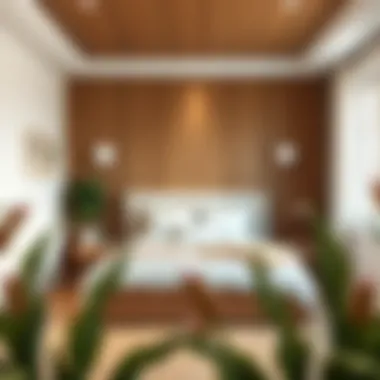
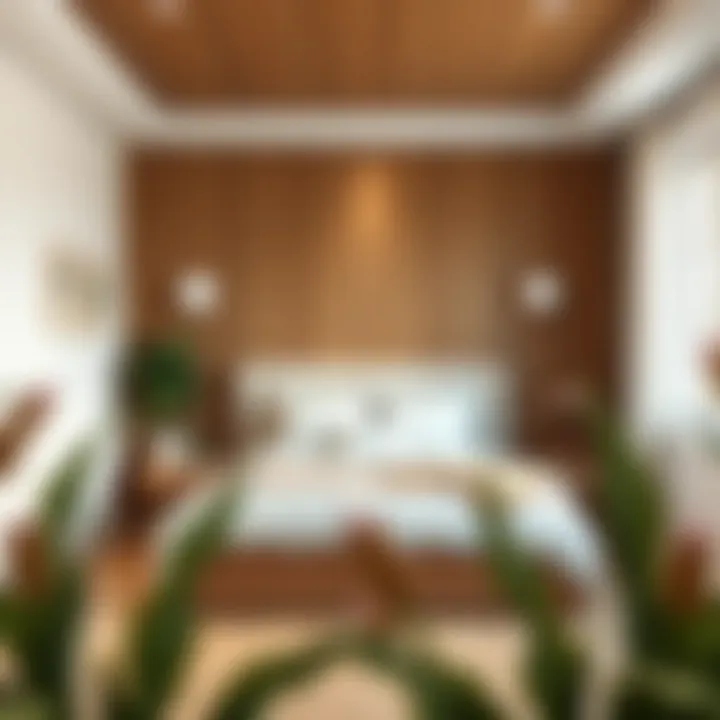
Sustainability sits at the forefront of modern design, especially when it comes to elements that are pivotal to interior aesthetics and functionality. Wall panels are no exception. As we delve into the sustainability aspect, we uncover how embracing eco-friendly materials can resonate well within design philosophies while also being kind to our planet. Adopting sustainable practices can not only reduce environmental impact but also enhance the overall quality and appeal of the spaces we inhabit.
Eco-Friendly Materials
Reclaimed Wood
Reclaimed wood is making waves in the realm of interior design, particularly when it comes to wall panels. This wood comes from old structures, like barns or factories, and is repurposed to create something new. The beauty of reclaimed wood lies not just in its story but also in its unique character. Each piece has its own history, often showcasing intricate grain patterns and rich colors that only time can develop. Using reclaimed wood is a winning choice not only because it keeps materials out of landfills but also adds warmth and authenticity to a space.
The key characteristic of reclaimed wood is its environmental significance. It helps reduce demand for new lumber, thus saving forests and promoting sustainability. However, it's worth noting that reclaimed wood may require more careful treatment, as it can sometimes harbor nails, screws, or chemicals from its past life, which should be thoroughly checked before installation. The potential for variability in quality means that sourcing from reputable suppliers is essential.
Bamboo Options
Bamboo has emerged as a popular alternative in the world of sustainable materials. This grass grows extraordinarily fast—up to three feet in a single day—which makes it a remarkably renewable resource. When utilized for wall panels, bamboo not only brings a visually appealing natural aesthetic but also boasts impressive durability and strength. It is water-resistant and, as a result, can withstand various environmental pressures, making it suitable for various applications.
The key characteristic of bamboo is its renewability. Harvesting bamboo doesn’t require cutting down the entire plant; instead, it can regenerate after harvesting, ensuring a consistent supply without harming the ecosystem. Bamboo wall panels, however, can be sensitive to moisture and temperature changes, which is an essential consideration for installation. Proper sealing and maintenance could prevent potential issues, but it's crucial that homeowners or designers evaluate their specific environments accordingly.
Lifecycle Assessment
Life cycle assessment is a systematic approach to evaluating the environmental impacts of wall panels from the production stage to disposal. Assessing the complete lifecycle can provide crucial insights, enabling designers and homeowners to make informed decisions about sustainability. This includes understanding where materials are sourced, the energy used in processing and transportation, as well as the long-term durability and recyclability of the materials used.
By weaving together these sustainability considerations into the fabric of wall panel choices, we not only honor our immediate design objectives but also our responsibilities toward the environment and future generations. Embracing eco-friendly materials like reclaimed wood and bamboo not only enhances aesthetic appeal but also fosters a sustainable ethos within our spaces.
Design Trends and Innovations
The world of interior design is ever-evolving, and staying ahead of the curve often means embracing the latest trends and innovations. Within the context of wall paneling, this evolution is not just about aesthetic appeal but also about functionality, adaptability, and sustainability. As homeowners and designers look to elevate spaces, understanding design trends in wall panels can make all the difference.
One significant trend is the integration of smart technology into wall panels. Smart panels can enhance a space beyond mere decoration. These panels often come equipped with tech features, such as built-in LED lighting, sound systems, or even temperature control. Homeowners can manipulate their living environments effortlessly through smartphone applications or voice commands. This blend of form and function speaks to a growing desire for interconnected, efficient home solutions.
In addition to smart technology, the push for customizable solutions reflects a broader cultural shift towards personalization in design. Homeowners want their spaces to reflect their unique tastes and lifestyles. Customizable wall panels allow for diverse options in color, material, and design patterns. Consider a family that loves the outdoors and wants to bring that ambiance inside. Custom wall panels can be designed to mimic natural textures, perhaps even integrating live plant features. This not only beautifies the space but fosters a connection to nature, an essential aspect of today’s design ethos.
Ultimately, these trends showcase how home environments adapt to the needs and preferences of their inhabitants. The rise of smart panels and customizable solutions not only enhances aesthetic and functional values but also paves the way for sustainable practices that resonate with eco-conscious consumers. The innovations in wall paneling aren't simply about what's trendy but rather a reflection of a redefinition of living spaces that prioritize harmony, efficiency, and individuality.
"The beauty of innovation in design is finding a balance between the latest trends and timeless elegance."
Smart Panels
Smart panels have revolutionized the approach to interior design. These panels can serve a multitude of purposes while still maintaining a sleek and modern appearance. For instance, some smart panels can emit ambient light or can be programmed to adjust based on the time of day. The versatility is simply unmatched.
Moreover, the incorporation of acoustics into smart panels addresses concerns about noise levels in home environments. Some panels are manufactured with specialized materials to absorb sound, offering an effective solution for those living in bustling urban areas or simply on a busy street. Homeowners can enjoy peace without sacrificing style.
When seeking to install smart panels, it’s essential to consider the compatibility with existing home automation systems. Ensuring that panels can integrate seamlessly with lights, security systems, or climate controls can enhance the overall functionality of the home.
Customizable Solutions
Customizable solutions offer homeowners the ability to tailor their wall panels to fit personal preferences and specific requirements. This aspect is paramount, especially when trying to create a cohesive look that resonates with one's taste.
By utilizing various materials such as reclaimed wood, fabric coverings, or even bespoke designs, clients can achieve a personalized flair. For instance, a contemporary industrial theme might call for metal panels with custom finishes, while a cozy, rustic home might benefit from custom-stained wooden panels.
Homeowners can also take advantage of dimensional wall panels that allow for intricate patterns to be created. This is particularly relevant in spaces like living rooms or dining areas, where a striking statement wall can become the focal point of the room.
In summary, embracing design trends and innovations in wall panels empowers homeowners and designers to create spaces that are both aesthetically pleasing and deeply personal. The smart integration of technology alongside customizable features paves the way for a future where every panel tells a unique story.
Challenges and Solutions
Navigating the realm of wall panels in interior design comes with its specific set of challenges. This section confronts these hurdles head-on, all while painting a clearer picture for homeowners and designers alike. Wall panels, while visually striking, may introduce costs and maintenance concerns that, if not addressed, could tarnish their intended effect. Grasping these challenges can significantly streamline project efficiency and positively impact budget management.
Cost Considerations
When delving into the installation of wall panels, the first thing that hits most homeowners is the budget. It’s essential to realize that while some wall panels appear economical, hidden costs have a tendency to lurk just around the corner. Here are some factors that often scramble the figures:
- Material Choices: The type of wall panels you select plays a huge role in determining costs. For instance, high-end materials like mahogany or cherry can run up your bill, compared to more budget-friendly options like plywood or MDF.
- Labor Expenses: Don’t forget about the labor costs! Hiring a skilled installer can be pricey, especially if the installation involves intricate patterns or requires special techniques.
- Additional Accessories: Sometimes, it’s the little extras that catch you off guard. Trim pieces, adhesives, and insulation can elevate your expenses.
It’s crucial to budget wisely and conduct thorough research on various options available in the market. Adopting a clear financial plan before making any decisions can help avert nasty surprises later on.
Maintenance Issues
Once wall panels are in place, the challenge shifts toward their upkeep. Maintaining wall panels isn’t just a walk in the park; it demands periodic care to keep them looking pristine. Neglecting maintenance could lead to costly repairs. Key maintenance tips include:
- Cleaning Regimen: Different materials come with different cleaning requirements. Wood panels may demand oil to maintain their luster, while metal surfaces might need specialized cleaners to avert tarnishing.
- Humidity Control: Especially for organic materials, fluctuating humidity levels can cause drama, leading to warping or mold. Regular checks can stave off these unwelcome guests.
- Prompt Repairs: Addressing scratches, dents, or general wear and tear quickly prevents minor issues from escalating into major headaches.
By keeping these considerations at the forefront, homeowners and designers can sustain the beauty and functionality of their wall panels. Each segment of the challenge presents an opportunity to foster greater awareness, ultimately enriching the experience of those who embrace the wall panel effect.
Ending
The conclusion of this exploration on the wall panel effect is not merely a summation, but rather a vital reflection on the profound impact these design elements can have on interior spaces. By understanding how wall panels function both aesthetically and practically, readers are equipped with a wealth of knowledge that can inform their design decisions.
Recap of the Wall Panel Effect
In essence, wall panels serve as a versatile tool in interior design. They offer more than just decorative charm; they enhance visual interest, infuse personality, and can drastically alter the perception of space. The choices in materials—be it wood, metal, or fabric—play an essential role in not only the style but also the functionality of a room.
Key points to consider include:
- Aesthetics: The ability of wall panels to transform a dull wall into a focal point through color and texture variations.
- Functionality: Contributions to acoustic properties, helping to reduce noise in environments that demand tranquility.
- Energy Efficiency: Providing thermal insulation which is particularly relevant in temperate climates where climate control is crucial.
"Wall panels not only beautify spaces but can be integral to effective sound management and temperature control."
The combination of these factors underscores why wall panels are not just a passing trend but a lasting feature in modern design.
Future of Wall Panels in Design
Looking ahead, the future of wall panels in interior design appears promising and rife with innovations. With technological advancements, smart wall panels that can adjust lighting or sound levels are on the rise. Customizable solutions allow homeowners and designers alike to create unique environments tailored to individual tastes.
Considerations for the future include:
- Sustainability: The increasing demand for eco-friendly materials will likely shape the development of wall panel products. Reclaimed wood and sustainable composites are becoming popular choices.
- Integration with Technology: The incorporation of features such as insulation, sound-proofing, and even integrated home automation systems into wall panels creates a multifunctional approach that meets modern living needs.
- Personalization: The trend towards bespoke designs allows for more expressive, individualized spaces in residential and commercial settings.
As designers adapt to these trends, one can expect the wall panel effect to evolve further, enhancing both the aesthetics and functionality of our environments.









